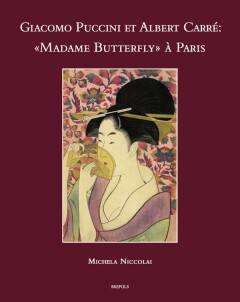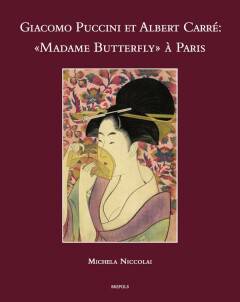
Je cadeautjes zeker op tijd in huis hebben voor de feestdagen? Kom langs in onze winkels en vind het perfecte geschenk!
- Afhalen na 1 uur in een winkel met voorraad
- Gratis thuislevering in België vanaf € 30
- Ruim aanbod met 7 miljoen producten
Je cadeautjes zeker op tijd in huis hebben voor de feestdagen? Kom langs in onze winkels en vind het perfecte geschenk!
- Afhalen na 1 uur in een winkel met voorraad
- Gratis thuislevering in België vanaf € 30
- Ruim aanbod met 7 miljoen producten
Zoeken
Giacomo Puccini et Albert Carré: « Madame Butterfly » à Paris
Madame Butterfly a Paris
Michela Niccolai
Hardcover | Frans
€ 121,90
+ 243 punten
Omschrijving
Following the failure of the Milan production of Madame Butterfly on 17 February 1904, Giacomo Puccini immersed himself in the consideration of a new structure for his "Japanese tragedy". After the emergence of several 'versions', the Paris premiere of Madame Butterfly has established a model for subsequent performances of the work up until the present. Collaboration with Albert Carre, manager and director of the Opera Comique, proved fundamental to the composer, who introduced many changes to its dramatic content and the musical score. The result is also reflected in the visual realization: Carre prepares a version that interacts with the score for a more modern result, taking into account the factors that were driving European theatre at the turn of the twentieth century. Beyond the careful attention paid to scenic movements (both for the soloists and the crowd scenes), the French director also pioneers a new form of lighting design. The latter is considered here as an inherent component of the spectacle in itself, made famous by the theoretical contribution of Adolphe Appia and other creative work in the field of Wagnerian opera. This staging, of which Puccini was especially proud, remained at the Opera-Comique until 1972. Knowledge of this document, presented here in a critical edition and accompanied by an article that underscores its functionality vis-a-vis the score will, it is hoped, prove useful to musicologists as well as to opera directors, with a view to achieving a rediscovery of the past, but also for the benefit of future theatrical productions. Suite a linsucces de la creation de Madama Butterfly a Milan (17 fevrier 1904), Giacomo Puccini se plonge dans la reflexion afin de donner une nouvelle structure a sa tragedie japonaise . Apres plusieurs versions, la creation parisienne de Madame Butterfly a etabli un modele pour les representations de luvre jusqua aujourdhui. La collaboration avec Albert Carre, directeur et metteur en scene a lOpera-Comique, se revele fondamentale pour le compositeur, qui apporte de nombreux changements dramaturgiques et musicaux a sa partition. Le resultat tient aussi de la realisation visuelle: Carre prepare une mise en scene qui interagit avec la partition pour un resultat des plus modernes, tenant compte des ferments theatraux qui animent lEurope au tournant du XXe siecle. Au-dela dune attention minutieuse portee aux mouvements sceniques (tant pour les solistes que pour les scenes de foule), le metteur en scene francais experimente egalement une nouvelle facon de concevoir leclairage scenique. Ce dernier est ici considere ainsi comme une composante du spectacle a part entiere, rendue celebre grace a lapport theorique et creatif dAdolphe Appia dans le domaine de lopera wagnerien. Cette mise en scene, dont Puccini allait particulierement fiere, est restee a lOpera-Comique jusquen 1972. La connaissance de ce document, presente ici en edition critique et accompagne dun article scientifique qui en souligne sa fonctionnalite vis-a-vis de la partition, nous lesperons, pourra etre utile tant aux musicologues quaux metteurs en scene lyriques, dans une perspective de redecouverte des mises en scene du passe mais aussi pour des nouvelles realisations sceniques.
Specificaties
Betrokkenen
- Auteur(s):
- Uitgeverij:
Inhoud
- Aantal bladzijden:
- 314
- Taal:
- Frans
Eigenschappen
- Productcode (EAN):
- 9782503547619
- Verschijningsdatum:
- 17/01/2013
- Uitvoering:
- Hardcover
- Formaat:
- Genaaid
- Gewicht:
- 340 g

Alleen bij Standaard Boekhandel
+ 243 punten op je klantenkaart van Standaard Boekhandel
Beoordelingen
We publiceren alleen reviews die voldoen aan de voorwaarden voor reviews. Bekijk onze voorwaarden voor reviews.









